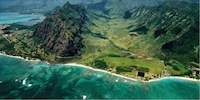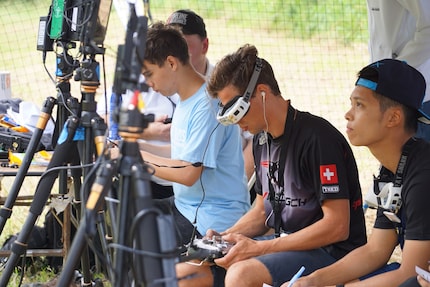
News + Trends
Visiting the World Drone Championships in Hawaii
by Rinalda von Allmen

Raphael Gion Strähl (27) comes from Oftringen, is a budding physiotherapist and a newly crowned European drone champion in the freestyle discipline. During the FPV Drone Racing World Championships in Hawaii, Raphael gave us an interesting insight into this up-and-coming sport.
First person view (FPV) drone racing is probably an unfamiliar term to most people. Briefly explain to us what exactly it is.
The term first-person view describes the fact that the pilot flies from the drone's perspective using goggles. The aim of the race is to complete a predetermined course as quickly as possible from this perspective. The sport started out very small in Switzerland, with a hard core of FPV enthusiasts meeting regularly to fly. At first, it was mainly freestyle flying, meaning that a cool spot with obstacles such as trees was chosen and flown around. The aim was to capture the most beautiful scenery possible and to fly a nice line with technically demanding figures, including manoeuvres such as rolls or loops.
Over time, drones became smaller, more agile and faster, giving rise to the discipline of racing. The scene has developed extremely quickly and there are now also team racing categories.
You recently won the European Freestyle Championship title, congratulations! How did you get into this sport in the first place?
I've been interested in remote-controlled things from a young age. When I was young, I first had various cars and aeroplanes that fascinated me. When my brother then bought a drone for filming, that opened another door for me too.
By chance, I came across the American group Flight Test on YouTube, which explained in a video how you can easily build aeroplanes from a foamboard. Later, they added instructions for a multicopter made from a wooden triangle. I was extremely fascinated by this do-it-yourself building and flying and later FPV emerged. Although the sport had been around for about five to six years, it was still largely unknown at the time. And that's how it got me. At the time, I didn't know anyone who did the same thing, so I had to teach myself everything. When I heard about the racing scene with the ever smaller and faster drones, I tried to reproduce the models with wood, but they usually broke completely in a crash. That's why I ordered my first carbon kit a year ago.

Do you assemble your drones yourself or are these models available for sale like this?
I assemble all the drones myself. There are drones that are delivered ready-to-run and you only have to buy the goggles and remote control. These models are quite good and robust, but not high-end machines. That's why everyone in the pro scene puts together their own equipment. The frames are specified by the manufacturers, but there are then thousands of rotors and electronic parts that are purchased in addition and two main software programmes that run well on them.
Are there any specifications at a contest as to what equipment you can fly?Yes, of course there are restrictions. At the moment, 300mm motor diagonal is the maximum allowed in most races. The batteries must not exceed 4 cells and the propeller size is only allowed up to 152mm (6 inches).
What does your training generally look like and how many hours do you train per week?
Until the Swiss Championships in August, I actually flew freestyle almost exclusively, without any specific training content. At some point, I realised that I also needed to train individual elements so that I could get faster in the races. The problem is that this hobby is pretty time-consuming. You're not just flying, but also tinkering around a lot when something breaks or new parts come onto the market. In addition, the drone has to be adjusted again and again (PID tuning) so that it is right for the manoeuvres. That takes a lot of time and experience. Lately, I've been spending eight to ten hours a week on the hobby.
How did you prepare specifically for the World Drone Championships?I flew a lot of races against other pilots to familiarise myself with the competition feeling. When you're competing against seven other people at the same time, it's very different to flying the course alone.
The field of competitors at the World Championships is large. How well do you know the other pilots? Do you know each other?
People know each other well within the scene. The pilots from America are mostly known from YouTube, as the sport is already more important in America and is organised more professionally. Here it's still more semi-professional, you can't make a living from it and everyone just does it on the side and tries to invest as much time as possible.
The atmosphere is very collegial, you get to know each other at the various events and help each other out. We also have a Facebook group where we constantly exchange ideas and spend a lot of time together at the weekends. And although it's actually a competitive sport, we have a lot of fun with each other. We really are like a small FPV family and have a great sense of cohesion.
What equipment do you use during the race?
Definitely my drone, goggles and a remote control. You also need a lot of batteries, as they run out after about 2.5 minutes of flying time, and a mobile charger to recharge the batteries. Tools and spare parts are also essential. I took a total of three drones with me to Hawaii, one for freestyle flying and two for racing. These are usually identical drones with the same settings, but you still usually have a drone that you favour.

What goal have you set yourself for the upcoming World Cup?
I know that the competition is very strong. My goal is to finish in the top half. If I qualify for the knockout rounds, I'll then see what happens next.
The prize money totals 100,000 dollars. What would you do with the money if you were to win?
I would certainly invest the money in my training and, of course, in new racing equipment.
Finally, do you have any tips for budding drone pilots?
The best way to familiarise yourself with the topic is via the internet. There are many videos and blogs that provide basic information. For beginners who have no idea about soldering and building and don't want to spend time selecting components, there are good starter packages that are supplied already assembled. It certainly helps if you can join someone with FPV experience or exchange ideas with other people on the internet. You can learn a lot of things on your own with YouTube videos or by using free simulators that you can download for free on your PC.
Thank you Raphael for the interview and good luck for the upcoming World Cup!
Raphael talks about his hobby and his experiences at the Drone Worlds in Hawaii on his YouTube channel.
From the latest iPhone to the return of 80s fashion. The editorial team will help you make sense of it all.
Show all